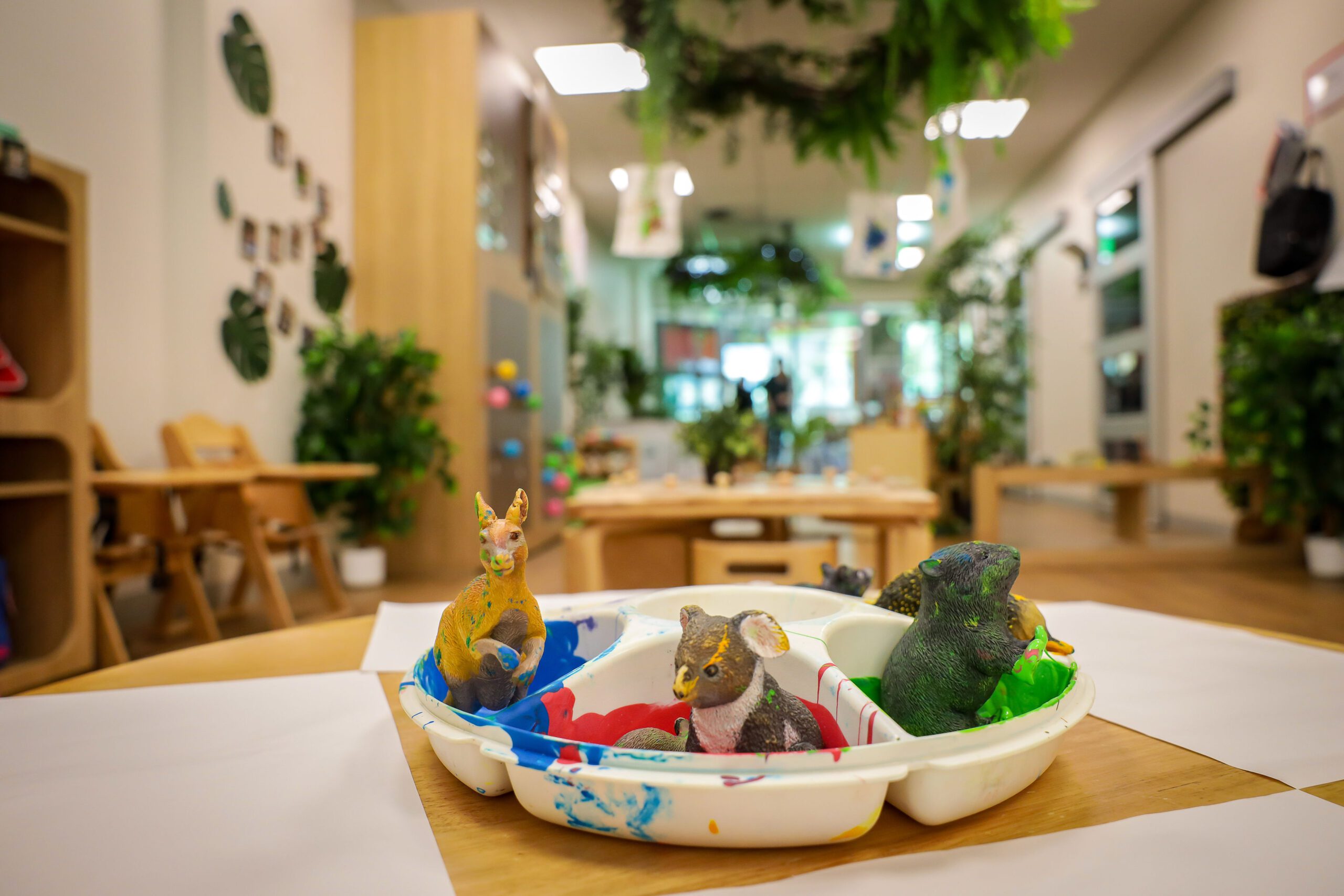
Finger painting is more than just a playful activity – it’s a valuable tool for toddlers’ holistic development. From sensory exploration and fine motor skills development to creative expression and emotional well-being, the benefits of finger painting are vast and enriching. Learn more about the benefits of finger painting for toddlers, as well as some ideas to try at home.
Finger Painting Benefits for Toddlers
Art is a vibrant canvas of exploration and learning, especially for young children. Of all the artistic activities, finger painting stands out as a favourite and just happens to be highly beneficial for toddler development. Here’s why:
Sensory Exploration
It is a sensory feast for toddlers. The squishy texture of paint, the smoothness of paper, and the varied colours stimulate their senses, promoting sensory exploration and cognitive development. As they dip their fingers into paint and spread it across the paper, toddlers engage in tactile experiences that enhance their understanding of textures and materials.
Fine Motor Skills Development
The act of finger painting involves intricate movements that are beneficial for refining fine motor skills. Toddlers learn to control their hand movements, strengthen hand muscles, and improve hand-eye coordination as they manipulate paint with their fingers. These foundational skills are essential for tasks like writing, self-feeding, and other activities that require dexterity.
Creative Expression
Finger painting empowers toddlers to express themselves freely and creatively. Unlike structured activities that may limit artistic exploration, finger painting allows toddlers to unleash their imagination without constraints. They can mix colours, create patterns, and experiment with different techniques, fostering a sense of autonomy and confidence in their artistic abilities.
Language Development
Engaging in finger painting also provides opportunities for language development. Toddlers often verbalize their thoughts, feelings, and observations as they paint, building vocabulary and communication skills. Encouraging conversations about colours, shapes, and the painting process enhances language comprehension and expression.
Emotional Expression and Relaxation
Finger painting serves as a therapeutic outlet for toddlers to express their emotions. Whether they’re feeling joyful, curious, or contemplative, the act of painting allows them to convey their feelings non-verbally. This expressive freedom promotes emotional awareness and relaxation, offering a calming and enjoyable experience for young minds.
Sensory Integration
For toddlers with sensory processing challenges, finger painting can be particularly beneficial. The sensory-rich nature of the activity supports sensory integration, helping toddlers process and organize sensory inputs more effectively. This can contribute to improved focus, attention, and overall sensory regulation.
Bonding and Social Interaction
Finger painting sessions often become joyful bonding experiences for toddlers and their caregivers or peers. Sharing the painting supplies, collaborating on art projects, and celebrating each other’s creations foster social interaction, cooperation, and a sense of camaraderie. These shared experiences strengthen relationships and create lasting memories.
Ideas to Try At Home
Finger painting with toddlers can be a wonderfully creative and engaging messy play experience. Here are some fun and interactive finger painting ideas specifically tailored for toddlers:
- Colourful Handprint Art: Encourage toddlers to dip their hands in different colours of paint and make handprints on a large sheet of paper or canvas. They can create handprint flowers, animals, or abstract patterns by overlapping handprints in various colours.
- Fruit and Vegetable Prints: Cut fruits and vegetables like apples, oranges, capsicums, and potatoes in half. Let toddlers dip the cut side into paint and press them onto paper to create unique prints. This activity not only explores textures but also introduces them to different shapes and colours.
- Rainbow Finger Trails: Create a rainbow effect by pouring different colours of paint in a row on a surface (e.g., a large tray or piece of paper). Encourage toddlers to drag their fingers through the paint, blending the colours together and creating vibrant rainbow trails.
- Bubble Wrap Stamping: Place bubble wrap on a flat surface with the bubbly side facing up. Apply paint on top of the bubble wrap, then invite toddlers to press their fingers onto the bubbles, transferring the paint onto paper. This creates a textured and colourful artwork.
- Ocean-themed Art: Use shades of blue and green paint to create an ocean backdrop on paper. Then, let toddlers dip their fingers in white paint to add waves, sea creatures, and bubbles to the scene. They can also use their fingers to draw fish, starfish, and seaweed.
- Seasonal Finger Painting: Tailor finger painting activities to match the seasons. For example, in spring, toddlers can create finger-painted flowers and butterflies. In autumn, they can make finger-painted leaves or pumpkin patches. Use seasonal colours and themes for added excitement.
- Sensory Texture Exploration: Provide a variety of textured materials like sand, salt, rice, or cotton balls alongside paint. Toddlers can experiment with dipping their fingers in paint and then pressing them onto these textured surfaces to create interesting patterns and tactile experiences.
- Dinosaur Fossil Prints: Create a prehistoric scene by making dinosaur fossil prints. Use toy dinosaur figures dipped in paint to make prints on paper. Toddlers can then use their fingers to add details like footprints, bones, and vegetation.
- Mixed-media Collage: Combine finger painting with collage elements like torn paper, fabric scraps, or natural materials (leaves, flowers). Toddlers can finger paint a background and then use their fingers to glue on collage items, creating a textured and multi-dimensional artwork.
- Storytelling with Finger Painting: Encourage toddlers to create a finger-painted scene from their favourite storybook or a story they make up. They can use their fingers to paint characters, settings, and plot elements, turning their artwork into a visual storytelling experience.
Finger painting is a great way for children to explore, learn, and develop through sensory play. These finger painting ideas not only spark creativity and imagination but also provide toddlers with opportunities to explore colours, textures, and artistic expression in a playful and hands-on way.